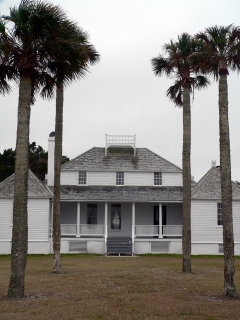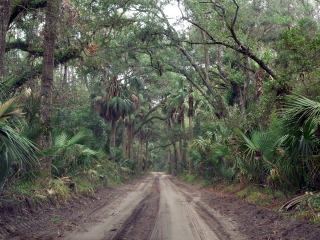Timucuan Ecological and Historical Preserve
near Jacksonville, Fla.
Visited: February 2, 2005
NPS Site Visited: 140 of 353
NPS Website; Local Website
 WHAT IS IT? WHAT IS IT?
46,000 acres existing mostly of salt marshes that border the slow urban sprawl of greater Jacksonville. The historical part of the preserve consists of a Sea Island cotton plantation and scattered Timucuan Indian ruins.
BEAUTY (3/10)
The Preserve is that garbled part of your northeastern Florida map where the Atlantic Ocean meets the fresh water of the St. John’s River. The terrain is mostly flat marshland, palms trees and many shades of green. The plantation home is stately, white and inaccessible to visitors because of structural damage. The slave quarter ruins reveal buildings constructed of tabby (oyster shells).
HISTORIC SIGNIFICANCE (4/10)
The Site’s historical presentation is a sprawling, jumbled confusing mess made even more vexing by its lack of Park Rangers, interpretive or otherwise. The Preserve covers at least four completely separate peoples and periods of history: pre-Columbian Timucuan Indians, 16th-century French Huguenots, 19th-century Sea Island slaves, and 1920’s socialites.
Many of the stories are fascinating but are told on neighboring exhibit panels and easy to mix up. The Preserve Museum and the Fort Caroline N MEM are one in the same. We found it difficult to get our heads around who, what, where and when. With Ranger assistance and clearer historical delineations, this site could be a trove of historical gems.
We believe we learned that the Timucuan were giant men averaging over 6’6” in height and that the Kingsley Plantation was run by a freed slave who was an African princess. She married Mr. Kingsley and they sold the Plantation after Florida became a part of the United States. The racial climate among slaves and owners in New Spain differed greatly than the “intolerant prejudice” found in the new American nation.
We wish it had been easier to learn more about this area’s intriguing past.
CROWDS (5/10)
Two vanloads of students proved more than the Plantation’s tiny Visitor Center/Bookstore could handle. Space restrictions have dictated the bookshelves’ place directly next to the entrance door. As a result, we struggled to get into the building and out of the rain; a dozen plus students were browsing the titles and blocked our way in. The volunteer on duty struggled to make sense of the chaotic scene around her while answering numerous questions. We came back later once the crowd had dispersed.
EASE OF USE/ACCESS (1/5)
Without a sea kayak, 75% of the Park is inaccessible. The Timucuan Preserve Visitor Center is located at the Fort Caroline N MEM, which exists only as an adjunct to the Preserve. There are a few hiking trails scattered throughout the Park.
 The Site’s historical centerpiece is the Kingsley Plantation, located on Fort George Island. A wide range of publications, including the USA Today, recommended the Plantation as a nice excursion during Jacksonville’s Super Bowl week festivities. The publicity has not warranted a paved road to the Plantation. It is a two-mile journey north from Route 105 down a single lane road reminiscent of a jeep trail seen in Jurassic Park. The Site’s historical centerpiece is the Kingsley Plantation, located on Fort George Island. A wide range of publications, including the USA Today, recommended the Plantation as a nice excursion during Jacksonville’s Super Bowl week festivities. The publicity has not warranted a paved road to the Plantation. It is a two-mile journey north from Route 105 down a single lane road reminiscent of a jeep trail seen in Jurassic Park.
CONCESSIONS/BOOKSTORE (3/5)
Bookstores at Fort Caroline N MEM and Kingsley Plantation have little in common although they service the same Ecological and Historical Preserve. A few books on people known as the Timucua can be found among the Fort Caroline histories. Some Florida-specific titles are among ubiquitous bird and nature guides. Looking through the store, there is little to explain what is special about the area or why is celebrated with a unique NPS designation.
Kingsley Plantation offers familiar essays and books by African American authors and a few site-specific gems like the collection of Zephaniah Kingsley’s writings entitled, Balancing Evils Judiciously where he elaborates his pro-slavery, pro-black views. Slave narratives and modern accounts of African American life in Jacksonville give this bookstore more focus and substance than its counterpart a Fort Caroline.
COSTS (4/5)
The Site is free, but it does not really get you much. You cannot go into the Kingsley Plantation.
Three Florida State Parks border the Timucuan Preserve. They all charge admission fees.
RANGER/GUIDE TO TOURIST RATIO (1/5)
No Rangers at the Timucuan Visitor Center (Fort Caroline N MEM) or the Plantation. And it was Super Bowl week.
The Fort Caroline N MEM volunteer did not place historical value in the Plantation as she curtly disparaged the freed African slave woman who ran the farm. At the Plantation, we found only a frazzled but helpful volunteer.
TOURS/CLASSES (3/10)
There is no video at either Visitor Center. No Ranger-led activities. A black and white pamphlet and a photocopied piece of paper were all we had to guide us around Kingsley Plantation. Even those were absent at Fort Caroline.
Exhibits in the Fort Caroline Visitor Center are pleasing to the eye, but difficult to follow. Low ceilings and bad acoustics don’t help.
 FUN (3/10) FUN (3/10)
What little fun we derived from the day came at the expense of Jacksonville, which became the punch line for most of our jokes.
WOULD WE RECOMMEND? (2/10)
Not in its present state. The Kingsley Plantation was especially disappointing. Nothing about this sea island location was familiar to us. We drove down its dirt road and felt transported to another era, a place whose history we have never learned or properly understood. At Kingsley, we found the physical historical resources but none of the necessary interpretive help. We hope that this will change.
TOTAL 29/80
|